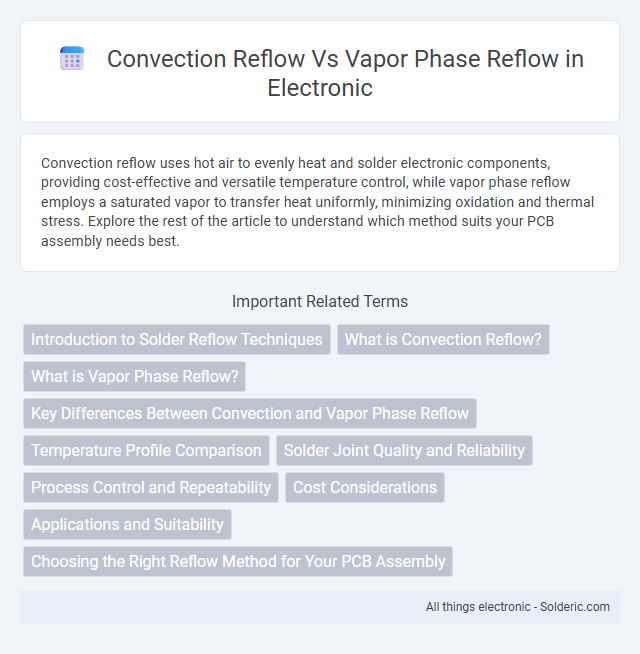Convection reflow uses hot air to evenly heat and solder electronic components, providing cost-effective and versatile temperature control, while vapor phase reflow employs a saturated vapor to transfer heat uniformly, minimizing oxidation and thermal stress. Explore the rest of the article to understand which method suits your PCB assembly needs best.
Comparison Table
| Feature | Convection Reflow | Vapor Phase Reflow |
|---|---|---|
| Heating Method | Hot air convection | Condensation of vaporized heat transfer fluid |
| Temperature Uniformity | Moderate, depends on airflow | High, uniform temperature across PCB |
| Maximum Temperature | Up to 300degC | Limited by fluid boiling point (typically 215-230degC) |
| Oxidation Risk | Higher, unless inert gas used | Low, vapor phase acts as inert atmosphere |
| Process Time | Faster, depending on heating profile | Longer due to controlled condensation |
| Equipment Cost | Lower | Higher |
| PCB Size Limitations | No significant limitations | Limited by vapor chamber size |
| Suitability | General SMT assembly | High-reliability or heat-sensitive components |
| Energy Efficiency | Moderate | High |
Introduction to Solder Reflow Techniques
Solder reflow techniques, including convection reflow and vapor phase reflow, are critical processes in surface mount technology (SMT) for mounting electronic components on PCBs. Convection reflow utilizes heated air to evenly transfer thermal energy, promoting uniform solder melting and solidification, while vapor phase reflow employs saturated vapor to achieve precise temperature control and minimize thermal stress on sensitive components. Understanding these methods enhances manufacturing efficiency, solder joint reliability, and overall electronic assembly quality.
What is Convection Reflow?
Convection reflow is a soldering process that uses heated air to evenly transfer heat to electronic circuit boards, allowing solder paste to melt and form reliable electrical connections. This method offers precise temperature control and consistent heat distribution, making it ideal for complex surface-mount technology (SMT) assemblies. Understanding convection reflow helps you optimize soldering quality and reduce defects in your manufacturing process.
What is Vapor Phase Reflow?
Vapor phase reflow is a soldering technique that uses heated vapor from a boiling liquid to uniformly transfer heat to electronic components, ensuring precise temperature control and minimizing thermal stress. This method contrasts with convection reflow, which relies on hot air circulation, making vapor phase ideal for complex or sensitive assemblies requiring consistent heat distribution. The process enhances solder joint quality by eliminating oxidation and enhancing flux activation through an oxygen-free environment.
Key Differences Between Convection and Vapor Phase Reflow
Convection reflow relies on heated air to transfer heat evenly across the PCB, ensuring consistent solder joint formation, while vapor phase reflow uses phase change of a boiling liquid to provide uniform heat transfer and precise temperature control. Vapor phase reflow minimizes oxidation and thermal stress due to its isothermal nature, whereas convection reflow may introduce temperature gradients and longer ramp times that can impact sensitive components. Your choice between these methods depends on production volume, component sensitivity, and the need for precise thermal profiling.
Temperature Profile Comparison
Convection reflow utilizes a controlled hot air environment to gradually increase and decrease the temperature, providing a typical temperature profile with distinct preheat, soak, and reflow stages, often reaching peak temperatures around 240degC. Vapor phase reflow involves condensing vapor of a high-boiling liquid onto the PCB, ensuring uniform, isothermal heat transfer with less thermal gradient and precise temperature control, usually limited to the boiling point of the vapor, commonly around 215degC. Your choice between these methods affects the temperature profile management, crucial for solder joint quality and minimizing thermal stress on components.
Solder Joint Quality and Reliability
Convection reflow provides consistent and controllable heating, resulting in uniformly melted solder joints with minimal thermal stress, which enhances joint reliability in most standard PCB assemblies. Vapor phase reflow uses saturated vapor to transfer heat, offering precise temperature control and oxygen-free environments that significantly reduce oxidation and improve solder joint quality, especially for complex or sensitive components. Your choice between these methods impacts the long-term durability and electrical performance of solder joints, with vapor phase often preferred for high-reliability applications.
Process Control and Repeatability
Convection reflow offers precise temperature control through multi-zone heating elements, enabling consistent thermal profiles essential for repeatable soldering quality. Vapor phase reflow utilizes the stable temperature of condensing vapor to ensure uniform heat transfer, dramatically reducing temperature variability and improving process control. Both methods provide excellent repeatability, but vapor phase reflow excels in minimizing hot spots and thermal gradients, enhancing solder joint reliability.
Cost Considerations
Convection reflow typically incurs lower initial equipment costs and energy consumption compared to vapor phase reflow, making it more cost-effective for small to medium production volumes. Vapor phase reflow involves higher capital investment due to specialized equipment and maintenance requirements but offers superior thermal uniformity, potentially reducing defect rates and rework costs in high-reliability applications. Evaluating total ownership costs, including throughput, yield, and maintenance, is essential when choosing between these soldering technologies.
Applications and Suitability
Convection reflow excels in soldering surface mount components on printed circuit boards (PCBs) and is suitable for medium to high-volume production with fine-pitch components. Vapor phase reflow is ideal for complex or high-reliability assemblies, such as aerospace or medical electronics, due to its uniform heat distribution and reduced thermal stress. Convection is cost-effective for mass production, while vapor phase offers superior temperature control for sensitive components and uneven board populations.
Choosing the Right Reflow Method for Your PCB Assembly
Selecting the right reflow method for your PCB assembly depends on factors such as component sensitivity, thermal profiles, and production volume. Convection reflow offers precise temperature control and is suitable for most standard assemblies, while vapor phase reflow ensures uniform heating with minimal thermal stress, ideal for sensitive or complex components. Your choice influences the quality, yield, and reliability of the final product, making it essential to match the method to your specific assembly requirements.
convection reflow vs vapor phase reflow Infographic

 solderic.com
solderic.com